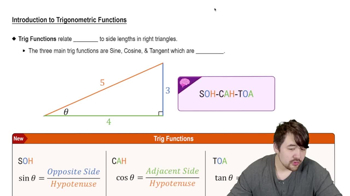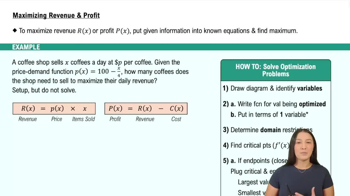Table of contents
- 0. Functions7h 52m
- Introduction to Functions16m
- Piecewise Functions10m
- Properties of Functions9m
- Common Functions1h 8m
- Transformations5m
- Combining Functions27m
- Exponent rules32m
- Exponential Functions28m
- Logarithmic Functions24m
- Properties of Logarithms34m
- Exponential & Logarithmic Equations35m
- Introduction to Trigonometric Functions38m
- Graphs of Trigonometric Functions44m
- Trigonometric Identities47m
- Inverse Trigonometric Functions48m
- 1. Limits and Continuity2h 2m
- 2. Intro to Derivatives1h 33m
- 3. Techniques of Differentiation3h 18m
- 4. Applications of Derivatives2h 38m
- 5. Graphical Applications of Derivatives6h 2m
- 6. Derivatives of Inverse, Exponential, & Logarithmic Functions2h 37m
- 7. Antiderivatives & Indefinite Integrals1h 26m
- 8. Definite Integrals4h 44m
- 9. Graphical Applications of Integrals2h 27m
- 10. Physics Applications of Integrals 2h 22m
5. Graphical Applications of Derivatives
Applied Optimization
Problem 4.5.61
Textbook Question
Metal rain gutters A rain gutter is made from sheets of metal 9 in wide. The gutters have a 3-in base and two 3-in sides, folded up at an angle Θ (see figure). What angle Θ maximizes the cross-sectional area of the gutter? <IMAGE>
 Verified step by step guidance
Verified step by step guidance1
First, understand that the cross-sectional area of the gutter is a trapezoid. The base is fixed at 3 inches, and the two sides are 3 inches each, folded at an angle Θ. The goal is to express the area as a function of Θ.
Next, express the height of the trapezoid in terms of Θ. The height can be found using trigonometry: it is the vertical component of the side, which is 3 * sin(Θ).
Now, express the top width of the trapezoid. The top width is the horizontal component of the two sides, which is 3 * cos(Θ) for each side. Therefore, the total top width is 3 + 2 * 3 * cos(Θ).
Write the formula for the area of the trapezoid: A(Θ) = (1/2) * (base + top width) * height. Substitute the expressions for the base, top width, and height in terms of Θ.
To find the angle Θ that maximizes the area, take the derivative of A(Θ) with respect to Θ, set it equal to zero, and solve for Θ. This will give the critical points. Use the second derivative test or analyze the critical points to determine which angle maximizes the area.
 Verified video answer for a similar problem:
Verified video answer for a similar problem:This video solution was recommended by our tutors as helpful for the problem above
Video duration:
8mPlay a video:
Was this helpful?
Key Concepts
Here are the essential concepts you must grasp in order to answer the question correctly.
Cross-Sectional Area
The cross-sectional area of a shape is the area of a slice taken perpendicular to its length. In the context of the rain gutter, it refers to the area formed by the base and the sides of the gutter when folded. Maximizing this area is crucial for ensuring the gutter can effectively channel water.
Recommended video:

Estimating the Area Under a Curve with Right Endpoints & Midpoint
Optimization
Optimization in calculus involves finding the maximum or minimum values of a function. In this problem, we need to determine the angle Θ that maximizes the cross-sectional area of the gutter. This typically involves using techniques such as taking derivatives and applying critical point analysis.
Recommended video:

Intro to Applied Optimization: Maximizing Area
Trigonometric Functions
Trigonometric functions, such as sine and cosine, relate the angles of a triangle to the ratios of its sides. In this scenario, the angle Θ will influence the height of the sides of the gutter, which in turn affects the cross-sectional area. Understanding these relationships is essential for setting up the optimization problem.
Recommended video:

Introduction to Trigonometric Functions

 1:13m
1:13mWatch next
Master Intro to Applied Optimization: Maximizing Area with a bite sized video explanation from Callie
Start learningRelated Videos
Related Practice








